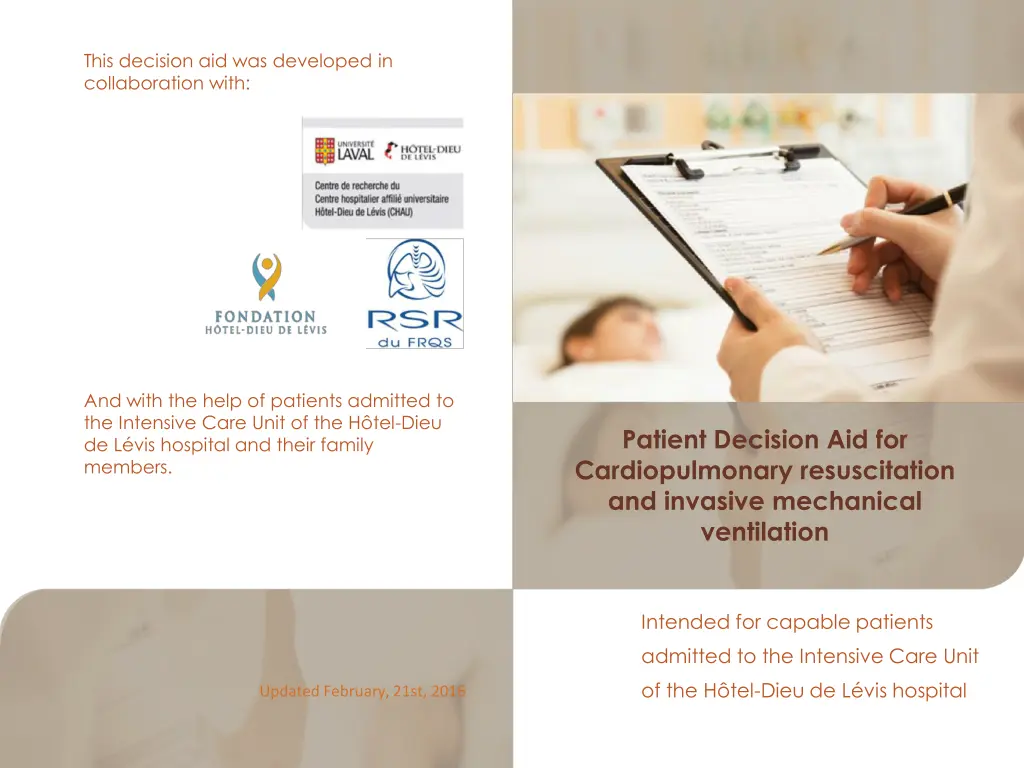
Decision Aid for Cardiopulmonary Resuscitation and Ventilation
A decision aid developed in collaboration with patients and their families at Hôtel-Dieu de Lévis hospital for discussing goals of care, CPR, and invasive mechanical ventilation in the ICU. Reflect on wishes, independence levels, benefits, and risks to make informed decisions.
Download Presentation

Please find below an Image/Link to download the presentation.
The content on the website is provided AS IS for your information and personal use only. It may not be sold, licensed, or shared on other websites without obtaining consent from the author. If you encounter any issues during the download, it is possible that the publisher has removed the file from their server.
You are allowed to download the files provided on this website for personal or commercial use, subject to the condition that they are used lawfully. All files are the property of their respective owners.
The content on the website is provided AS IS for your information and personal use only. It may not be sold, licensed, or shared on other websites without obtaining consent from the author.
E N D
Presentation Transcript
This decision aid was developed in collaboration with: And with the help of patients admitted to the Intensive Care Unit of the H tel-Dieu de L vis hospital and their family members. Patient Decision Aid for Cardiopulmonary resuscitation and invasive mechanical ventilation Intended for capable patients admitted to the Intensive Care Unit of the H tel-Dieu de L vis hospital Updated February, 21st, 2016
What happens after this conversation? Introduction Once admitted to the intensive care unit, it is important to clarify your goals of care to ensure that the interventions offered to you are in line health and your wishes. Your goals of care will be added to your medical chart and your treatment plan will be adjusted, accordingly. There are four differentgoals of care : You can always change your mind. Just let a team member know. This document was created to help prepare you to have a discussion with your physician. In particular, you will discuss your wishes, current and anticipated levels of independence and two interventions: : If you have any questions or concerns about the information provided in this decision aid, please feel free to discuss your concerns with your care team. 1: Cardiopulmonary Resuscitation (or CPR) 2:Invasive mechanical ventilation (being connected to a breathing machine) 11 2
Your wishes and current and anticipated levels of independence Summary This document presented you with two interventions. You reflected on your wishes and your current and anticipated levels of independence. Below are a few questions to help your care team get to know you: Do you know anyone who has experienced CPR or invasive mechanical ventilation ? For now, if your heart stops beating, would like your care team to attempt CPR? you Yes No Undecided If necessary, would you want to be kept alive with invasive mechanical ventilation? What are your wishes when it comes to CPR and invasive mechanical ventilation? Yes No Undecided Notes 3 10
What are the benefits and the risks of Invasive Mechanical Ventilation? Before your current hospitalization, how did you complete your day-to-day activities? (Check all that apply) If your condition necessitates the use of invasive mechanical ventilation, you can still die whether or not you accept this intervention. If you accept invasive mechanical ventilation, the chances of surviving are higher, but the sIde effects are also higher. without help? with an assisting device? (ex: a cane, a walker) with adaptation? (ex: wheelchair ramps) BENEFITS RISKS Can avoid sudden death Complications (ex: pneumonia) with human help? (ex: help from a family member, home health aide) Can possibly regain former level of independence and leave the hospital Emotional and physical suffering If you lose your independence after this hospitalization, would you accept to live: (check all that apply) If you refuse invasive mechanical ventilation, other less aggressive and less effective therapies could be offered to you. If invasive mechanical ventilation or other less aggressive and less effective therapies were to fail, you would be offered palliative care. at home with help? in a long-term care facility for semi- independent persons? in a long-term care facility for non- independent persons? 9 4
Intervention #2 Invasive Mechanical Ventilation When would prolonging your life become unacceptable? (you can choose all that apply) Invasive mechanical ventilation takes place with the help of a machine that artificially reproduces natural breathing. The machine pushes oxygen into the lungs through a breathing tube installed through the month into the lungs. If I were no longer able to communicate with others If I were no longer able to control of my personal care If I were bedridden but still able to communicate with others Before reading this document, had you already thought about : yes no your wishes to accept or not CPR and/or invasive mechanical ventilation Invasive mechanical ventilation does not, in-and-of- itself, heal the primary health condition. the factors that would make prolonging your life unacceptable? It keeps the patient alive so that the carel team can try and address the primary condition. During invasive mechanical ventilation, medication to the patient to reduce their discomfort. During invasive mechanical ventilation, patients cannot eat or speak normally. Have you written these wishes somewhere? care team administers (ex: a living will) 5 8
Intervention #1 Cardiopulmonary Resuscitation (CPR) What are the benefits and the risks of Cardiopulmonary Resuscitation (CPR)? Cardiopulmonary resuscitation (CPR) is a group of interventions used to try and restart the heart of an individual that has stopped beating. If a person s heart stops beating and nothing is done, the person dies a painless death. If CPR is attempted, the individual has between 0 to 30% chance of survival, depending on their medical condition . BENEFITS RISKS Can avoid a sudden death Brain injury Can possible regain former level of independence and leave the hospital Fractured ribs When CPR is performed in a hospital : 1. Blood circulation is maintained by a cardiac massage Your physician will be able to explain your chance of survival and your anticipated level of independence following CPR. 2.A tube is inserted in the mouth to assist breathing (intubation and invasive mechanical ventilation) 3. Electric shocks (defibrillation) can be used 4.Medication is administered 1 Ebell et al., 2014 et Canadian Researchers at the End-of-Life Network 7 6






















